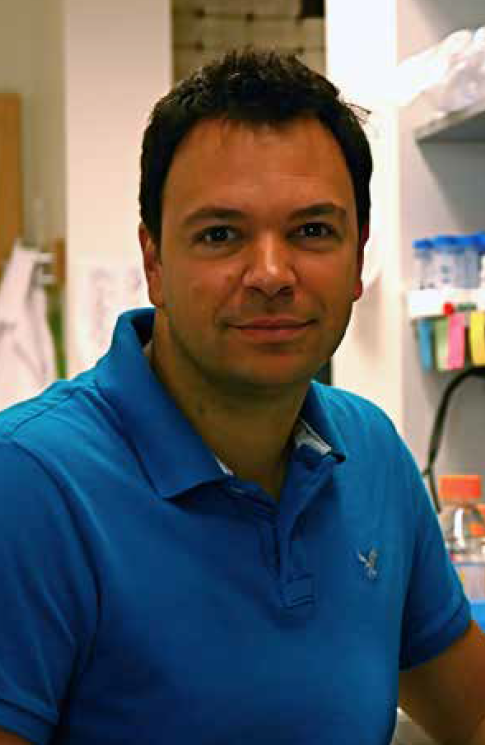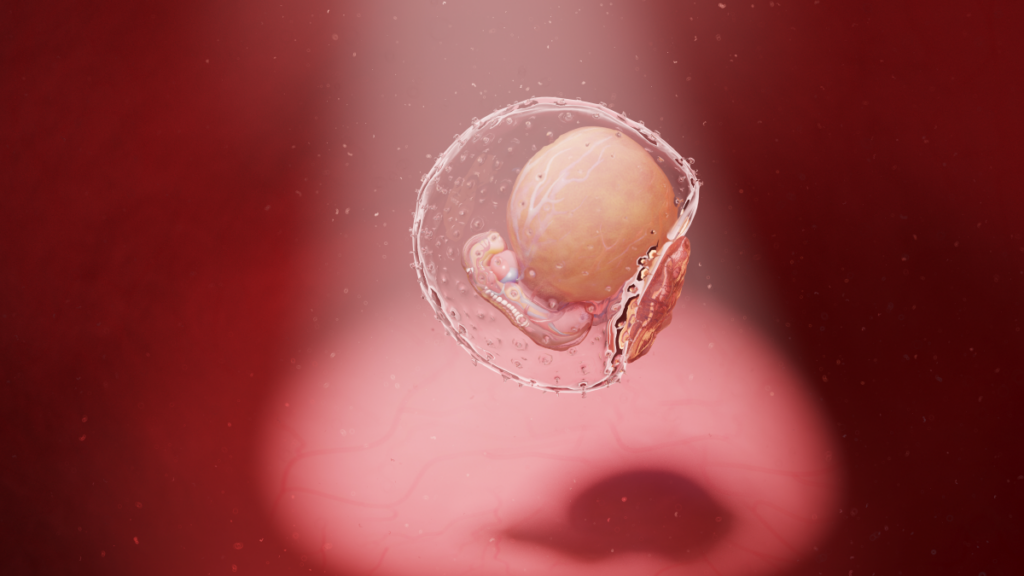Portrait of a Scientist and Mentor
Geneticist and developmental biologist Antonio Giraldez investigates where human life begins.
Published December 1, 2014
By Daniel Krieger
Academy Contributor

Antonio Giraldez, a geneticist and developmental biologist specializing in embryos, sees the trajectory of his career in a rather unusual light. For Giraldez, there’s a clear parallel between his own development as a scientist and the fundamental transition an embryo undergoes that marks the beginning of life.
When an embryo initially forms, instructions from the mother’s body guide the first few hours of development. Then, the embryo’s own genome activates, and development continues according to its instructions. “Think of it as breaking the link with your mom when you become a teenager,” Giraldez says. “She has taught you a lot of things, but you need to explore the world on your own. The embryo does that, too.”
His long-term investigations into how this biological process works have led to important discoveries, all of which stem from his endless fascination with the mechanisms that make life happen. “How a fertilized egg makes a new organism shows that the book of life is written with the same language,” he says. “The same instructions are used over and over to make very different species and different parts of the animals, and when these signals are activated in the wrong place or time, that can cause disease, which is why we need to understand how animals develop from an egg.”
A Scientist is Born
An only child growing up in Jerez, a city in southwestern Spain, Giraldez’s interest in science was first sparked by fire. When he was eight, he moved beyond merely setting things aflame after his parents gave him a children’s chemistry set called The Little Chemist. “It was much more dangerous than the ones they sell nowadays,” he says. “You could do real experiments.” So he set about mixing all kinds of chemicals that would bubble, smoke and even explode—reactions that pleased him to no end.
Despite his inquisitive nature, Giraldez was a lackluster student until his 8th grade science teacher inspired him by having students conduct physics experiments and learn about natural science through experimentation. From that point on, he took school much more seriously and grew to love everything related to science—especially chemistry.
In high school, a teacher gave him the keys to the lab where he would spend hours playing scientist. “It was great fun,” Giraldez says. Meanwhile, at home, he continued his own experiments with chemicals his father brought home from the sherry winery where he worked. He got his first practical lessons in biology—and stank up the house—growing things in petri dishes, from fungus to bacteria, using a closable desk as an incubator.
Reading and experimenting fueled Giraldez’s passion for science, which just kept growing. When it came time for college, though uncertain about his future, his course of study was clear. While majoring in chemistry at the University of Cádiz, he conducted many experiments—like one he devised to figure out how to prevent white wine from spoiling.
The Chemistry of Life
But his interest soon shifted to “the chemistry of life,” and that led Giraldez to the University Autónoma of Madrid, where he got his first exposure to developmental biology. It was there that Dr. Ginéz Morata, an esteemed developmental biologist specializing in fly genetics, took Giraldez under his wing and steered him on a new path of inquiry that continues to this day. “I learned that by modifying genes, we can modify how an organism is made,” he says. “It’s like playing god. My fascination with that hasn’t diminished since.”
Giraldez parted ways with his undergraduate mentor when he pursued a PhD at the European Molecular Biology Laboratory in Heidelberg, Germany, where he dove deeper into research of fly genetics under the guidance of his new mentor, geneticist Stephen Cohen. Living and breathing science like never before, he thrived in this highly collaborative and multidisciplinary environment, interacting with top-notch scientists from around the world. “It was a dream come true,” he says.
His work, studying the genes that regulate the wing-signaling pathways of flies, was a major step in his evolution as a scientist. “Every day I would go to the microscope and find new genes that were changing the shape of how a fly is made,” he says. Once, while examining mutant flies without wings, he identified a new gene needed for reading instructions to make a wing. “I had a wonderful time doing this genetic screening and discovered something new every day.”
A Budding Young Scientist

Giraldez came to the United States to complete his postdoctoral work—a move he deemed necessary for any budding young scientist. He was drawn to New York University—and later, to Harvard—by his next mentor, Dr. Alexander Schier, a molecular and cellular biologist with whom he felt a special kinship. However, he had doubts about what avenue of inquiry to pursue next. He felt it was time to branch out into uncharted territory.
As it turned out, Giraldez’ lab in Heidelberg had been one of the first to identify microRNAs—tiny regulators of gene expression—in a fly embryo. It wasn’t yet known if microRNAs were widespread in vertebrates, and answering that question struck Giraldez as an exciting prospect. “I wanted to find out what they were doing in the making of a vertebrate,” he says, having suspected that microRNAs played an important role.
Using zebrafish, he discovered that microRNAs facilitate the process by which a fertilized egg becomes a multicellular embryo by helping it cast off instructions from the mother as it develops. “By learning how the embryo gets rid of these previous instructions, we also learned a fundamental function of how these microRNAs regulate other genes and their mechanisms,” he says. Giraldez was starting to make his mark.
When he arrived at Yale in 2006, where he is currently an associate professor in the Department of Genetics at the School of Medicine, Giraldez was eager to continue his investigation of microRNAs and their role in regulating embryo development. In 2009, he and his team reported that they had mapped how two particular microRNAs affect hundreds of muscle genes in a zebrafish embryo.
“New Molecular Scissors”
The following year, he made news again, publishing the discovery of “new molecular scissors” that Giraldez says represent a novel method by which cells make microRNAs that are essential to the creation of red blood cells. His initial hunch years earlier—that microRNAs play a key role in the formation of both animals and disease—had been right.
Today, Giraldez oversees a lab of 20 researchers, and he has moved beyond the study of microRNAs, which are just one piece of the puzzle in understanding how the embryo regulates genes. He is now studying the trigger that jumpstarts an embryo’s life.
“We want to understand how the first genes get activated because that sets off a domino effect in the making of an embryo,” he says. “This activation is what initiates the deletion of the maternal instructions, but we now realize that the microRNA is not the only mechanism that accomplishes this task. We have uncovered novel mechanisms used by the embryo to clean the slate.”
“These processes are crucial,” he says, “because later steps, like the making of the heart, eyes, or skin, depend on the very first step in that cascade being activated correctly.” Giraldez and his team found, for instance, that the proteins that trigger initial development in embryos are the same ones that can reprogram mature, differentiated cells into pluripotent stem cells.
The implications of fully understanding how genes are activated to make a new embryo can be far-reaching, especially in the treatment of disease. “Learning how embryos clean the slate may teach us, for example, how a cell is able to erase its previous programming to become a tumor cell, and to then proliferate and invade other tissues,” he says.
Numerous Accolades
While at Yale, Giraldez has been the recipient of numerous honors. He was a faculty finalist in the inaugural year of the Blavatnik Awards for Young Scientists in 2007, and he received the John Kendrew Young Investigator Award from the European Molecular Biology Laboratory the same year.
He also received the Lois E. and Franklin H. Top, Jr., Yale Scholar Award and was named a Pew Scholar in biomedical sciences. This year, he was awarded the Vilcek Prize for Creative Promise in Biomedical Science in recognition of his groundbreaking research that uncovered the role of microRNAs in the regulation of gene expression in embryos.
Throughout his path as a scientist—from the early spark that set off his own growth and development through the many stages that followed—Giraldez has followed his passion. He credits a blend of chance opportunities and his lucky encounters with life-changing mentors at key transitional moments for shaping his work and directing his career.
Now a mentor himself, he takes great pleasure in continuing the cycle, guiding his students as they devise their own experiments and make new discoveries. One of his longtime mentees, Carter Takacs, a senior investigator in his lab, has observed his commitment to this process. “He really values being able to help younger scientists grow and mature,” he says.
Daniel Krieger is a writer, photographer and reporter with over a decade of journalistic experience.
This story originally appeared in the fall 2014 issue of The New York Academy of Sciences Magazine.